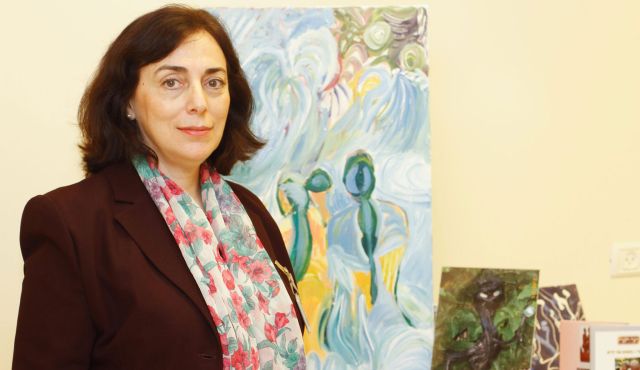Sheba study: Parkinson's treatment improves creativity
By Dan Even | Nov.26, 2012 | Haaretz
Studies released this year reveal that patients who were administered with dopamine to treat Parkinson's disease have developed creative talents such as drawing, sculpting, and poetry.

Prof. Rivka Inzelberg at her clinic. Photo by Nir Keidar
Administering dopamine to patients with Parkinson's disease can uncover latent creative talents among them, according to studies released this year, including a survey done by an Israeli researcher.
After noting that one of their Parkinson's patients had suddenly began to publish books of poetry, doctors at Turku University Hospital, in Turku, Finland, decided to survey 290 Parkinson's patients being treated there, and found that 19.3 percent testified to boosted creativity since being diagnosed with Parkinson's. A third of these attributed their creative behavior to the dopamine they had started taking to get their tremors and other symptoms under control.
The researchers reported their findings in the May issue of Case Reports in Neurology, and concluded that artistic tendencies can be enhanced in Parkinson's patients taking the drug, though these are often accompanied by a decreased ability to control one's impulses.
Now a new Israeli medical article, which reviews 26 other studies and descriptions in the medical literature, also points to the increased tendency of Parkinson's patients to exhibit creative skills, whether in drawing, sculpture, poetry or other writing. The article had its genesis in observations conducted in the clinic of Prof. Rivka Inzelberg, a neurology researcher at Tel Aviv University and at the Joseph Sagol Neuroscience Center at Sheba Medical Center.
"Parkinson's patients had in recent years started to bring me works of art that they had created - paintings, sculptures and poems," said Inzelberg, who began to conjecture about their artistic tendencies.
Among those described in the article are a number of patients who began to draw and paint after starting dopamine treatment, a woman who started to embroider, a patient who had been a scriptwriter but who claimed that the treatment had improved his writing abilities and an architect who, after starting treatment, had began to paint nude women, until his dosage was reduced, after which he began to paint clothed people.
"These patients apparently began to engage in divergent thinking, that is, broad, meandering, open thinking that is typical of creative people," Inzelberg said. These artistic tendencies are also linked to another behavior that has been noticed among Parkinson's patients - a penchant for collecting things.
"It's known that Parkinson's patients being treated [with dopamine] are liable to exhibit a reduced ability to control their impulses, and are inclined to collect lots of things that seem to be superfluous, like notes, plastic containers, covers, bottle caps and buttons - or they start gambling," the researcher explained. "It could be that the artistic tendencies are essentially an expression of that same uncontrolled compulsion that manifests itself in painting or sculpting day and night."
With that, the tendency toward creativity has also been noted in patients who do not exhibit uncontrolled impulses.
The link between dopamine and creativity has long been known outside its connection to Parkinson's patients or to medicine in general. There are artists who reportedly take dopamine-increasing drugs, such as Ecstasy and cannabis, before going on stage.
Inzelberg has her reservations. "It's not clear whether the drugs these artists take increase their creativity or just make them happier," she said.
Some 25,000 Israelis suffer from Parkinson's, which results from a lack of dopamine in the brain, and expresses itself in motor disturbances, including stiffness and tremors. The Israeli research collected information from numerous Western medical centers, and suggests that Parkinson's patients who exhibit artistic tendencies are those who undergo dopamine therapy. The study also found that the artistic expressions increase with an increase in the dosage.
Dopamine is a neurotransmitter that helps control the brain's reward and pleasure centers. It helps to regulate movement and emotional responses and enables people to perceive rewards and work toward them. One of the breakthroughs in Parkinson's research was the development of the drug L-Dopa, which is able to cross the blood-brain barrier and increase the level of dopamine in the brain. This drug, first developed in 1911, remains one of the most effective treatments for Parkinson's.
These latest findings are liable to encourage researchers to develop a "creativity pill," but Inzelberg isn't enthusiastic. "Developing something like that wouldn't be simple, because at the other extreme, increased dopamine activity is liable to cause psychotic episodes," she said.
"It's also possible that there are factors encouraging creativity in Parkinson's patients other than dopamine, because not every Parkinson's patient treated with dopamine suddenly becomes creative."
The exact mechanism through which dopamine spurs creativity is not yet known.
But after writing the article, which was recently accepted for publication by the journal Behavioral Neuroscience, Inzelberg has started a new study at Tel Aviv University that will investigate the connection between Parkinson's and creativity and will try to ascertain the link between these creative tendencies and the different drugs used to treat the disease.









